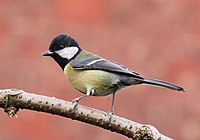
Photo from wikipedia
In temperate regions, some avian haemosporidian parasites have evolved seasonal transmission strategies, with chronic infections relapsing during spring and transmission peaking during the hosts’ breeding season. Because lineages with seasonal… Click to show full abstract
In temperate regions, some avian haemosporidian parasites have evolved seasonal transmission strategies, with chronic infections relapsing during spring and transmission peaking during the hosts’ breeding season. Because lineages with seasonal transmission strategies are unlikely to produce gametocytes in winter, we predicted that (1) resident birds living within wintering areas of Neotropical migrants would unlikely be infected with North American parasite lineages; and (2) if infected, wintering migratory birds would be more likely to harbor Plasmodium spp. rather than Parahaemoproteus spp. or Haemoproteus spp. parasites in their bloodstreams, as only Plasmodium produces life stages, other than gametocytes, that infect red blood cells. To test these predictions, we used molecular detection and microscopy to compare the diversity and prevalence of haemosporidian parasites among year-round residents and wintering migratory birds during February 2016, on three islands of The Bahamas archipelago, i.e., Andros, Grand Bahama, and Great Abaco. Infection prevalence was low and comparable between migratory (15/111) and resident (15/129) individuals, and it did not differ significantly among islands. Out of the 12 lineages detected infecting migratory birds, five were transmitted in North America; four lineages could have been transmitted during breeding, wintering, or migration; and three lineages were likely transmitted in The Bahamas. Resident birds mostly carried lineages endemic to the Caribbean region. All North American–transmitted parasite lineages detected among migratory birds were Plasmodium spp. Our findings suggest that haemosporidian parasites of migrants shift resource allocation seasonally, minimizing the production of gametocytes during winter, with low risk of infection spillover to resident birds.
Journal Title: Parasitology Research
Year Published: 2020
Link to full text (if available)
Share on Social Media: Sign Up to like & get
recommendations!